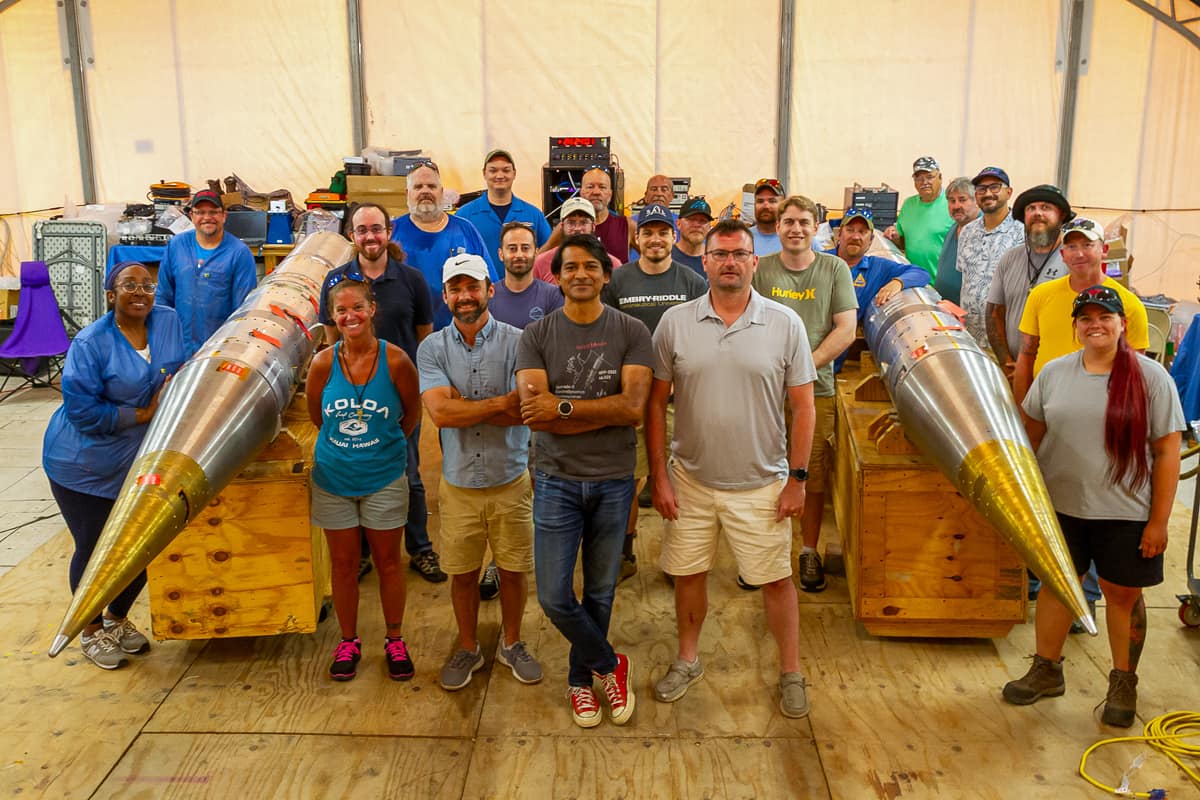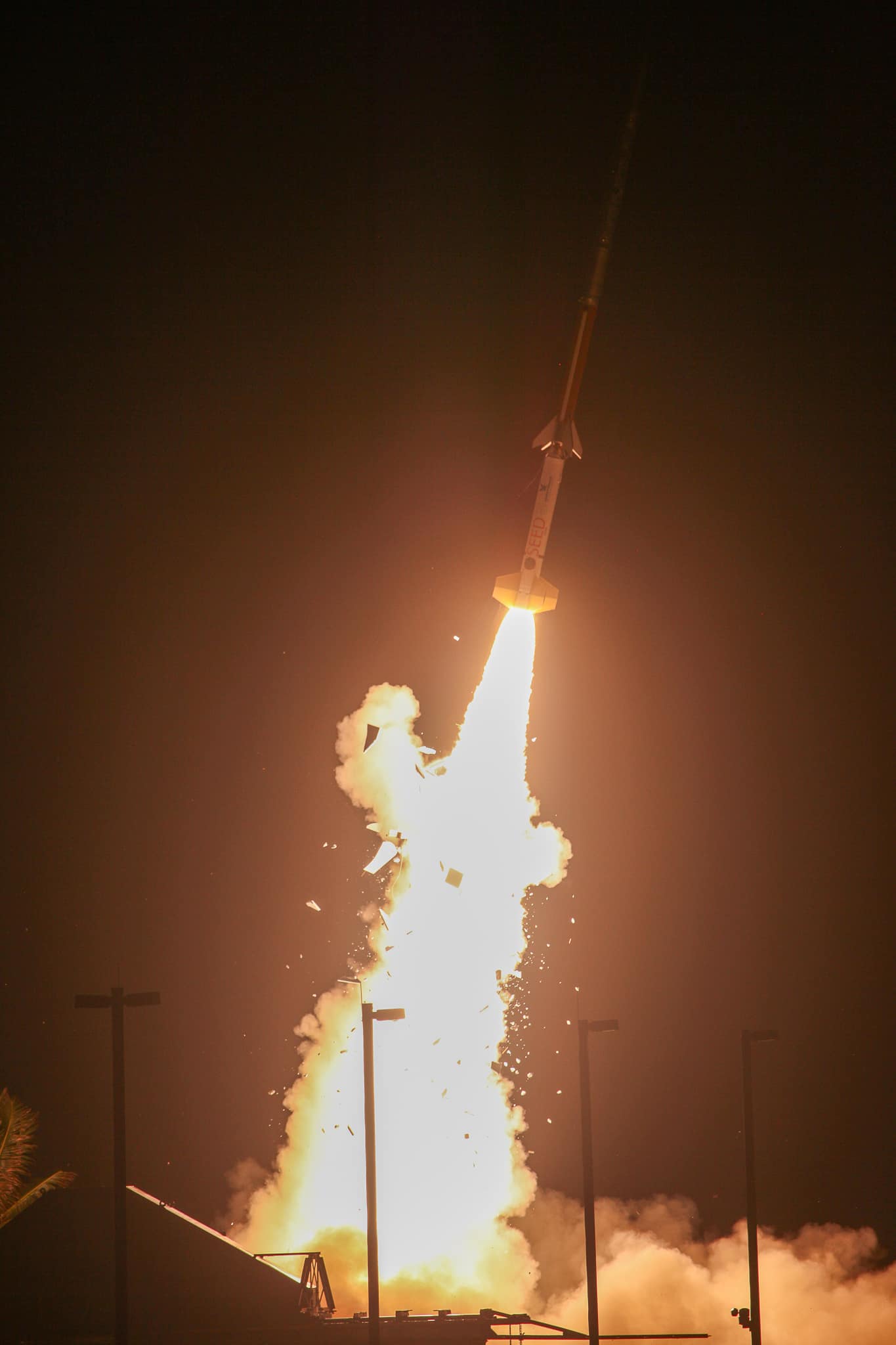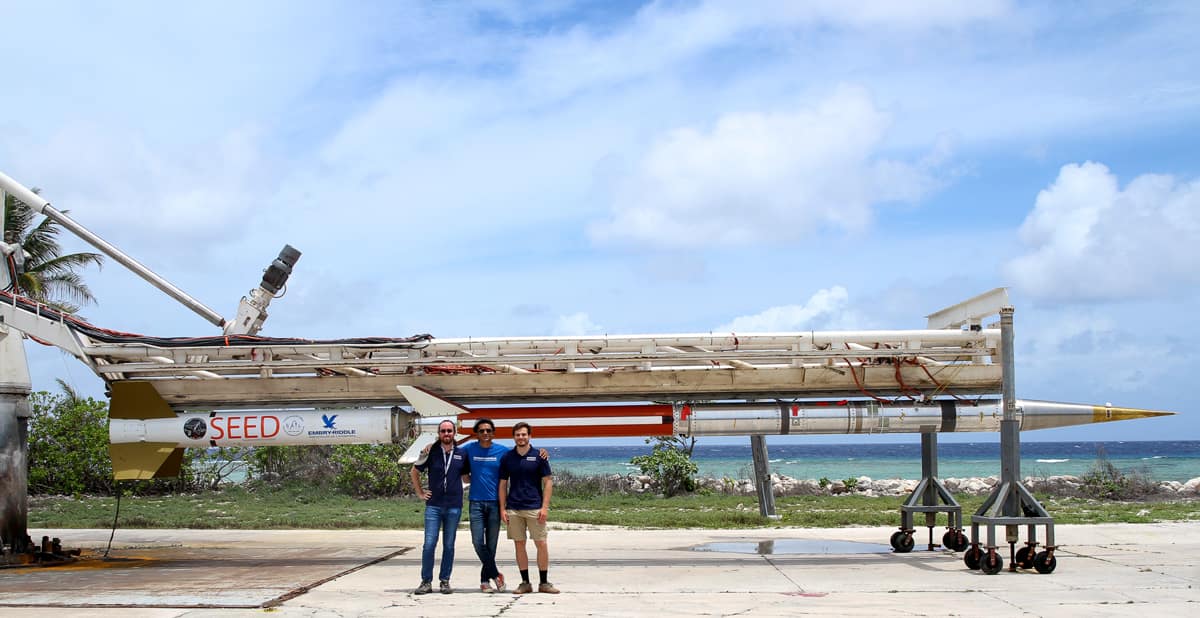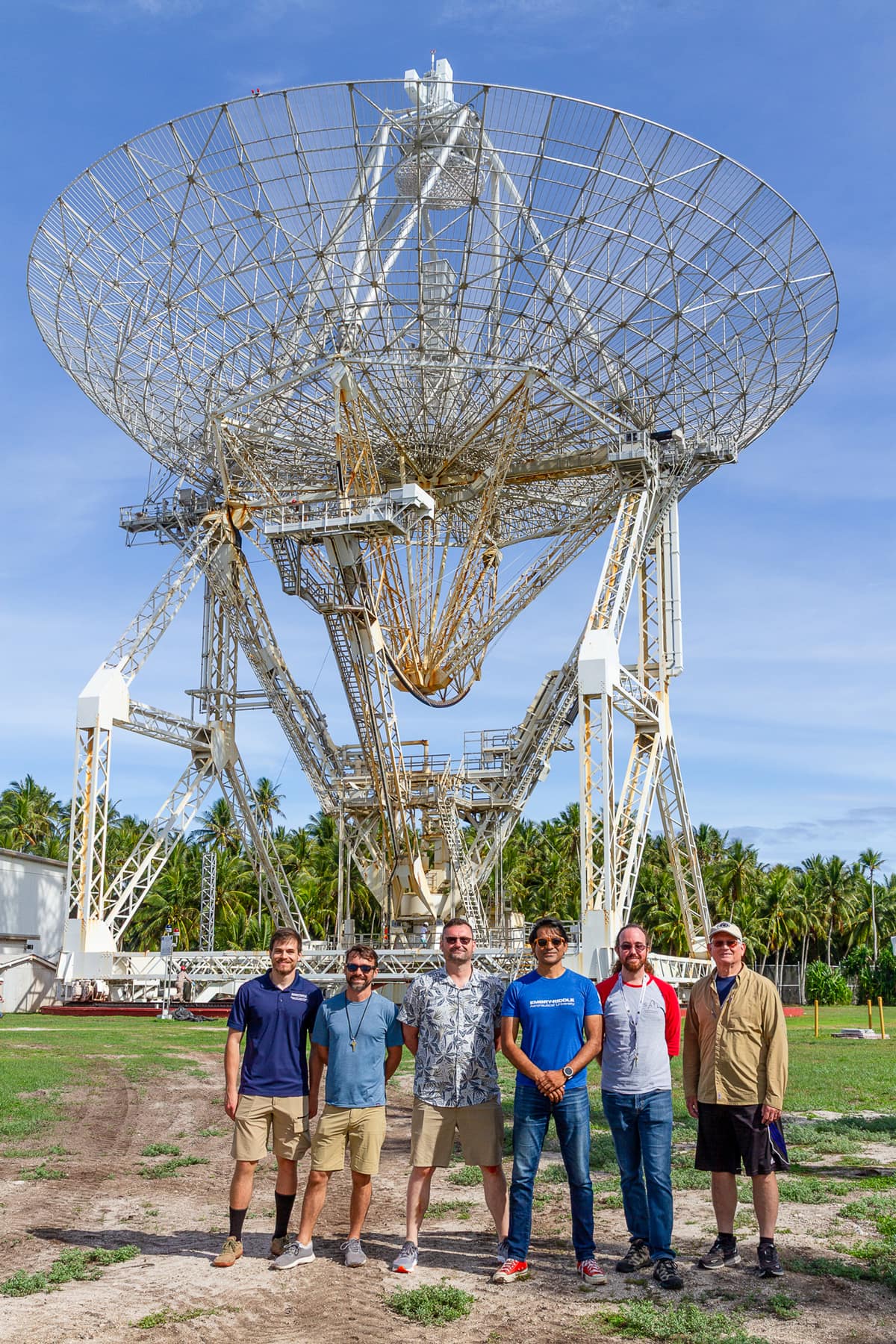Embry-Riddle Researchers Launch Rockets for a Deeper Look at Ionized Clouds That Disrupt Communications

Embry-Riddle researchers recently shot two 46-foot-tall rockets into clouds high in the Earth’s atmosphere to learn more about the complex dynamics that affect critical communications and radar operations.

The first of the two rocket launches for the SEED campaign. (Photo: Chris Lanier/NASA) The NASA-sponsored mission, led by Dr. Aroh Barjatya, professor of Engineering Physics, lifted off in late June from the remote Kwajalein Atoll, part of the Republic of Marshall Islands in the Pacific.
The rocket mission was designed to investigate ionized clouds, known as Sporadic E layers, which are invisible to the naked eye and form in the ionosphere. Named for its abundance of ionized, or charged, particles, the ionosphere is a layer of the Earth’s atmosphere 40 to 600 miles (60 – 1,000 km) above the Earth’s surface.
As meteors race in from space, they burn up and leave behind ionized particles of iron, magnesium, calcium, sodium and potassium in the ionosphere. These particles are heavier than the primary components of nitrogen and oxygen in the ionosphere, and typically sink to its lower levels, where they clump together, forming Sporadic E clouds at around 60-70 miles (90-115 km) of altitude.
These clouds can disrupt air traffic control and marine radio signals, as well as other forms of radio communication.
“Understanding the ionosphere is crucial to keeping our communications systems running properly,” said Barjatya, who was at the liftoff site and gave the signal to launch each rocket outfitted with a payload of scientific instruments.
When radio signals transmitted on Earth encounter the dense Sporadic E layers when reflecting off the ionosphere, the dense clouds cause the signals to bounce at unpredicted lower altitudes, rather than reflecting as usual in the upper layers of the ionosphere. This changes the angle of their reflection, inviting interference from distant locations and garbling the signals.
Besides creating radio communications problems, Sporadic E clouds can also interfere with military radar systems used to see beyond the horizon, resulting in false targets known as “ghosts.” The various disruptions caused by the Sporadic E layers are difficult to anticipate, because the clouds form, move and dissipate constantly.
Although the systems affected are generally designed to make them as resistant to disruptions as possible, “that does not mean that we can predict when, where or how strong a Sporadic E layer will form,” said Barjatya, director of the Space and Atmospheric Instrumentation Lab (SAIL) at Embry-Riddle, which is part of the Center for Space and Atmospheric Research (CSAR), one of the university’s Centers of Excellence.
Barjatya, who is also the interim executive director of CSAR, added that “the science is still trying to figure out the prediction part.”
Ph.D. candidate Nathan Graves, who also traveled to Kwajalein Atoll for the launches, said measurements made from inside the Sporadic E layers are more precise than those from ground sensors. “The most important thing for us is understanding the physical processes involved in Sporadic Es,” he said.
A Mystery in the Sky Above the Equator
The mission from Kwajalein, called SEED (Sporadic E Electro Dynamics), involved sending two sounding rockets directly into the dense clusters. Sounding rockets, which are uncrewed, generally fly for about 10 minutes but can be targeted at fleeting space phenomena. Kwajalein, at a latitude of roughly nine degrees north, is the closest launch site to the equator from which NASA regularly launches.
The researchers chose to launch from Kwajalein to investigate one of the mysteries of Sporadic E clouds.

Dr. Robert Clayton, Dr. Aroh Barjatya, and Nathan Graves (left to right) in front of one of the SEED rockets mounted on the launch rail. (Photo: Chris Lanier/NASA)
If you think of the Earth as being a sphere inside of an apple, the lines of the Earth’s magnetic field are like the outlines of the slices of the apple. Those outlines would run nearly parallel to the Earth’s surface at the equator but would slant toward the Earth at the top and bottom.
The formation of the Sporadic E layers in the latitudes well above and below the equator can be attributed to the heavy particles following the lines of the Earth’s magnetic field as they slant in toward the Earth at the North and South poles through atmospheric layers with varying wind patterns. This causes the particles to pile up, creating the enhanced density layers.
Near the equator, however, the lines of the magnetic field, like the lines of the apple slices, run nearly parallel to the Earth’s surface. Yet even so, the Sporadic E clouds form. The formation mechanism is not entirely understood.
Dr. Robert Clayton, a research scientist in SAIL who also traveled to the launch site, said, “We launched near the equator to study the physics that existing theory doesn’t fully explain.”
Countdown to Liftoff
Before the rockets launched, Barjatya and his team, collaborating with Boston College researchers, used ALTAIR (ARPA Long-Range Tracking and Instrumentation Radar) to monitor the skies above Kwajalein Atoll. ALTAIR is one of the most powerful radars of its kind and has a steerable beam that allows a detailed look at the ionosphere along a rocket trajectory, in this case ensuring that the rocket would intersect with the targeted patchy layers.

The SEED team in front of the ALTAIR (ARPA Long-Range Tracking and Instrumentation Radar), which provided data to monitor the
Sporadic E layers in real time and determine the Go/No-Go launch
decision. (Photo: Chris Lanier/NASA)
Once the team detected that Sporadic E layers were forming, Barjatya gave the call to launch. The first rocket took off on June 20 and the second on June 28 — one reached 94 miles (152 km) and the other 98 miles (158 km).
Each rocket payload deployed four dropsondes, or atmospheric measurement devices, about the size of two-liter soda bottles. The dropsondes were ejected from the rockets to achieve simultaneous multi-point measurements of ion and neutral particle density and magnetic field at different locations within the ionized clouds. All of the scientific instruments carried on the rockets to measure the Sporadic E layers were built by students and scientists in SAIL.
The first rocket also released colorful tracers built by Clemson University that glowed in the night sky and were photographed from the ground, providing remote measurements of the prevailing winds in the lower ionosphere.
Both launches were successful. All the instruments worked as intended, and the mission yielded valuable information, Barjatya said. “We have lots of data to analyze for months to come.”
“We are slowly chipping away at getting further understanding of Sporadic Es,” Barjatya said, “and making progress on someday being able to predict their occurrence.”
Graves, who plans to complete his Ph.D. in the fall, has been involved in the SEED mission since his sophomore year at Embry-Riddle and wrote much of the code for the operation of the scientific instruments carried aboard the rockets.

Nathan Graves solves a Rubik's Cube underwater at 100 meters of depth. A Ph.D. candidate who wrote much of the coding for the operation of the instruments carried on the SEED rockets, Graves belongs to Embry-Riddle’s Speedcubing Club. (Photo: Robert Clayton/Embry-Riddle)In 2022, Graves traveled with Barjatya’s team to an entirely different location for another rocket launch. It took place near the North Pole, where he swam in icy Arctic waters. While on the Kwajalein atoll, awaiting the more recent launches, he not only swam in the balmy tropical waters but also managed to take scuba lessons and earn his diving certification. “Being able to travel the world to remote science-only locations is a significant bonus to all the incredible science and engineering I get to do,” he said.
After Graves earns his Ph.D., he will continue in SAIL as a research scientist.
“More projects, more rockets and satellites,” he said. “I like that.”
Other students who worked on the SEED mission, but have since graduated, included Megan Soll and Johnathan Bizzano (both with bachelor’s degrees in Engineering Physics), Joshua Milford and Peter Ribbens (with master’s degrees in Engineering Physics), and Rachel Conway and Henry Valentine (with Ph.D. degrees in Engineering Physics).

 Michaela Jarvis
Michaela Jarvis